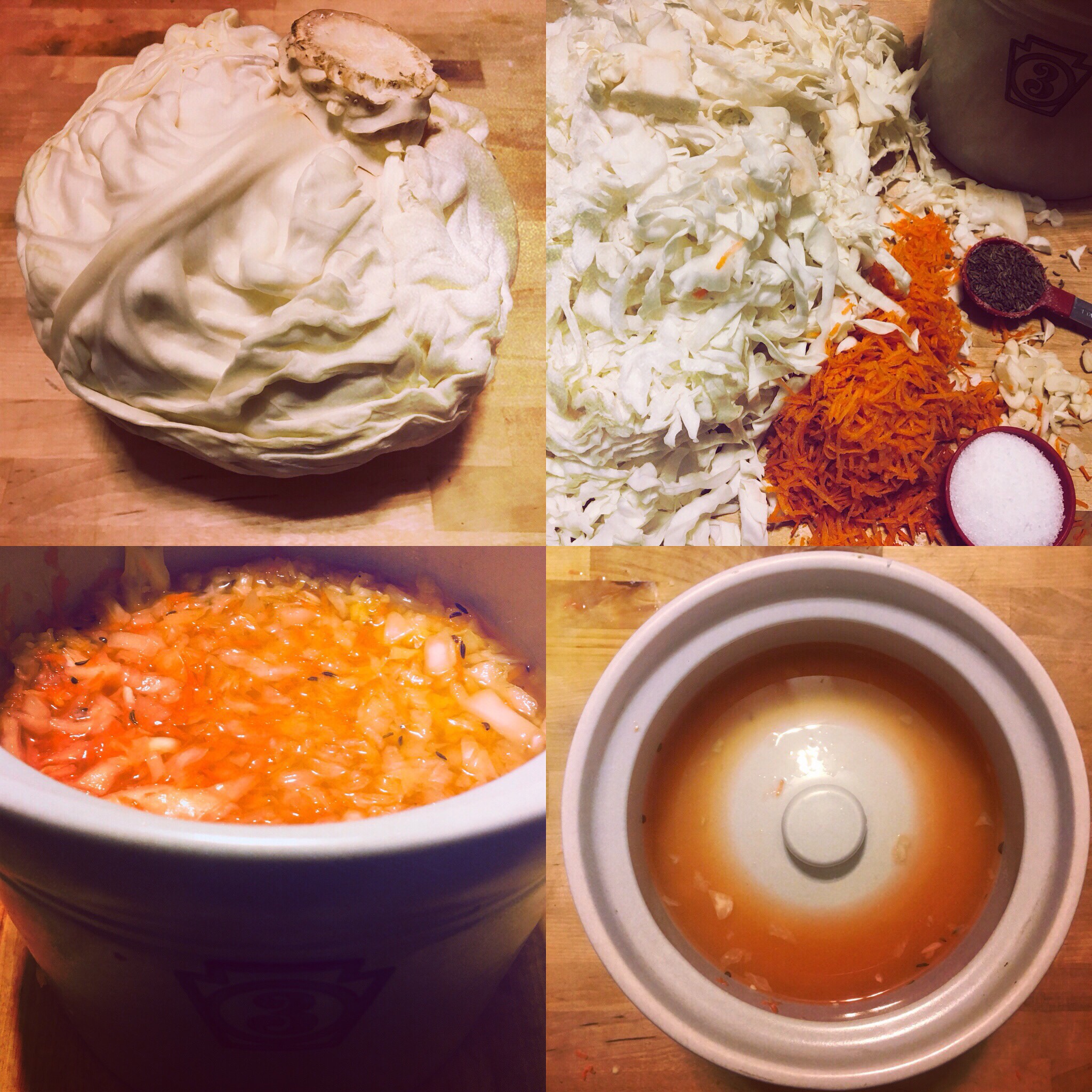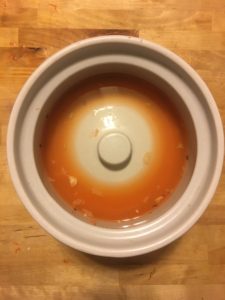
I have attempted to make sauerkraut a few times over the years. The first time was an ultimate failure…I had used a purple cabbage and used kosher salt (bad movie) and when I opened the sauerkraut crock as it fermented, I knew something had gone awfully wrong. Rule number one of making sauerkraut: It will always smell kinda pungent and sour as it ferments, and will grow a little mold here and there that you can scrape away, but if the smell makes you gag, throw it away. Easy.
Fast forward seven years, and I knew I had gained enough food preservation skills to do it right. The recipe below is loosely based on my friend Leah’s kraut recipe that she swears by. Her recipe uses ginger and dill, whereas mine uses caraway seeds and garlic. This is the second time I’ve made this recipe, and I made an extra adjustment by adding a few finely shredded carrots. Going to eat fermented foods AND get extra beta carotene from those carrots? Awesome!
Some tips:
- As a general rule of thumb, use sea salt instead of kosher salt. An unrefined, mineral rich salt is best. Table salts contain iodine and anti-caking agents which can impact the fermenting process and make your veggies taste too salty.
- For each 5 pounds of cabbage, use approximately 3 tablespoons of salt, aiming for a 2% saltwater brine solution.
Ingredients
- One head of cabbage (mine weighed 3.7 pounds)
- 3 medium sized carrots, finely shredded
- 4-5 garlic bulbs, sliced
- 1 tbsp caraway seed
- 2 tbsp salt
Directions
Step 1: Prepare your Ingredients
Remove any outer layers of the cabbage and then remove its core and discard.
 Cut the cabbage in quarters and slice into thin ribbons. Thinly shred the carrots, and slice the garlic.
Cut the cabbage in quarters and slice into thin ribbons. Thinly shred the carrots, and slice the garlic.

Step 2: Add to Crock or Fermentor
In a 3 or 5 gallon crock, layer the cabbage, shredded carrots, caraway seeds, salt, and garlic until you fill up the jar.

In between layers, smash it down with a wooden spoon, your fists, or another sturdy kitchen tool to create space as you add additional layers as you pack the crock until all of the ingredients are gone.
Step 3: Smash it!
Once all ingredients have been added, continue to tamp down until there is about a 1/2 inch of water above the sauerkraut mixture that has been forced out of the cabbage creating its own brine. I sometimes will use a mason jar to tamp it down until this happens. Don’t give up! It should take about 10 minutes or so.

Step 4: Submerge Ingredients
Cover kraut with a plate or some other lid that fits snugly inside the crock. The lid from from my other crock fit perfectly inside. You can also place a clean weight (a glass jug filled with water) on the cover to continue to force the water out of the cabbage and keep everything submerged under the brine. Pressing down on the weight or plate will push more water out of it as well. If you are nervous at all about the amount of liquid, you can add a tablespoon or so if tap water to the jar. Make sure all of the sauerkraut is kept under the brine as any exposed to the air will mold. Put a lid or loose cover over the crock to keep dust out.

Step 5: Test and Wait
Let the sauerkraut ferment, checking every few days. I keep mine in a corner of the kitchen and place in a cupboard if the kitchen starts to smell a bit tangy as it starts to ferment. Sauerkraut ferments best at a temperature range of 65-72° F. Continue to check on on the kraut, tasting it until it reaches the desired ferment. It should take about 2-3 weeks. In warmer temperatures, it will take a shorter amount of time to ferment. If your house is cooler, then you will need to ferment it for a longer time period. Sometimes mold appears on the surface, and you can skim it off on the surface, knowing that everything submerged in the anaerobic environment below is protected.
Step 6: Taste and Enjoy
When the texture gets to where you like it, transfer into mason jars, refrigerate, and enjoy!

Carrot Caraway Kraut
Ingredients
- One head of cabbage mine weighed 3.7 pounds
- 3 Medium sized carrots finely shredded
- 4-5 Garlic bulbs sliced
- 1 tbsp Caraway seed
- 2 tbsp Salt
Instructions
-
Prepare your Ingredients: Remove any outer layers of the cabbage and then remove its core and discard. Cut the cabbage in quarters and slice into thin ribbons. Thinly shred the carrots, and slice the garlic.
-
Add to Crock or Fermentor:In a 3 or 5 gallon crock, layer the cabbage, shredded carrots, caraway seeds, salt, and garlic until you fill up the jar. In between layers, smash it down with a wooden spoon, your fists, or another sturdy kitchen tool to as you add additional layers as you pack the crock until all of the ingredients are gone.
-
Prepare your Ingredients: Once all ingredients have been added, continue to tamp down until there is about a 1/2 inch of water above the sauerkraut mixture that has been forced out of the cabbage creating its own brine. I sometimes will use a mason jar to tamp it down until this happens. Don't give up! It should take about 10 minutes or so.
-
Submerge Ingredients: Cover kraut with a plate or some other lid that fits snugly inside the crock. You can also place a clean weight (a glass jug filled with water) on the cover to continue to force the water out of the cabbage and keep everything submerged under the brine. Pressing down on the weight or plate will push more water out of it as well. Make sure all of the sauerkraut is kept under the brine as any exposed to the air will mold. Put a lid or loose cover over the crock to keep dust out.
-
Test and Wait: Let the sauerkraut ferment, checking every few days. I keep mine in a corner of the kitchen and place in a cupboard if the kitchen starts to smell a bit tangy as it starts to ferment. Continue to check on on the kraut, tasting it until it reaches the desired ferment. It should take about 2-3 weeks. Sometimes mold appears on the surface, and you can skim it off on the surface.
-
Taste and Enjoy: When the texture gets to where you like it, transfer into mason jars, refrigerate, and enjoy!